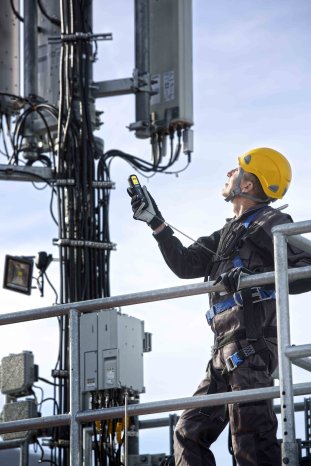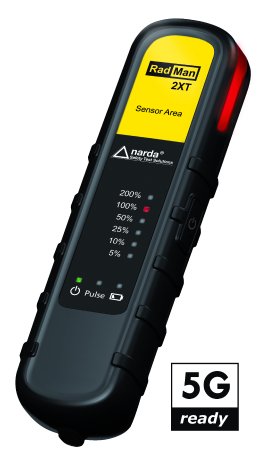Workers in unknown electromagnetic fields can easily determine if the levels are within the safe limits with a RadMan 2 clipped to their belt, particularly when working in an unknown EMF/RF environment. The shaped frequency response of the personal monitor ensures that the correct alarm threshold is automatically set for the entire frequency range. The permitted limit values specified in the standards vary depending on frequency. As the device has sensors for the E field (electric) as well as for the H field (magnetic), the distance between the field source and the person is immaterial – whether in a strong electric or magnetic field. The higher value of either will always trigger the alarm and will be displayed as a percentage of the applicable upper limit, e.g. as stipulated by ICNIRP/FCC/IEEE/SC-6. The unit has three alarm indicators, ultra-bright flashing LED, loud audible and also vibrates. With these alarm indicators you are sure not to miss a warning.
The unit is simple and easy to use, power it on and your protected. The unit performs a self-check of the electronics and more importantly a sensor test to confirm that the sensors are functioning correctly. An external test generator is no longer required to test the unit is functioning. This self-test capability incorporated in the RadMan 2 for the first time in any personal monitor, provides a sense of confidence. A special RF absorber between
the sensor and the body ensures that the actual field strength is measured accurately and correctly during operation by eliminating the effects of the body such as reflections, which could lead to inaccurate readings. The Radman is not only robust and weatherproof, with its IP-65 rated housing. With one hand operation, the unit can easily be removed from its holder to perform isotropic field exposure measurements and leaks from coaxial cable and connectors (image 1). This ensures the reliable display of all hotspots in both the E field and the H field, regardless of the orientation of the device. The built-in rechargeable batteries give an unprecedented 800 hours of operating time from a single charge.
Highest frequency coverage
There are two versions of the RadMan 2 available: the less expensive LT model for up to 8 GHz, with reduced features and fewer functions, but with the same premium protection level typical of Narda devices as its “bigger brother”, the XT, with its range of up to 60 GHz. With what is currently the highest frequency coverage on the market, it is capable of providing sure, reliable warning of radio and radar frequency fields as well as of 5G millimeter waves.
RF absorber for greater precision
Following in the footsteps of the original, highly successful RadMan, the RadMan 2 has now appeared as a worthy successor after more than 20 years. It has inherited only the best features of the original. For example: only the special RF absorber ensures that the device can measure electromagnetic fields when worn on the person without affecting the accuracy of the result. The signal reflections caused by the body would otherwise impact on the displayed result, negatively affecting safety. The absorber material for the new device is a permanent part of the special holder for the climbing harness and belt, so that when the device is used correctly it is automatically always where it belongs, between the body and the sensor, even when the device is unhooked.
E field and H field sensors
The personal monitor is equipped with both E field (electric) and H field (magnetic) sensors for applications in the near field and far field regions of TV and radio antennas. In contrast with conditions in the far field, the electric and magnetic fields in the near field are independent of each other. This means that it is possible for the person requiring protection to move through regions in the near field where there is a strong magnetic field and a very weak electric field or vice versa. Users of the RadMan 2 do not need to know which field region they are in, or to have to set the device up accordingly. It automatically gives a correct warning, regardless of the field type and the distance from the source. If worst comes to the worst, the higher value of the two fields will trigger the alarm.
The personal monitor is easily released from the special holder using just one hand. Once released, the device measures the field isotopically, i.e. non-directionally. This ensures that all hotspots in both the E field and the H field are reliably displayed regardless of the direction in which the device is pointing. This practically eliminates erroneous assessment of the field, as the device basically does not have a blind spot.
XT special features: Tone search function and Pulse Mode
The XT version allows the user to make a precise search for leaks at arm’s length (image 1), such as on waveguides or coaxial connectors with the tone search function. As the field source is approached, the change in the pitch of the tone allows the user to quickly, simply, and reliably check that the antenna is actually switched off before getting too close. A further highly advantageous feature of the XT version (image 2) is its “Pulse” mode, which enables reliable detection of brief, pulsed signals. The alarm responds much faster in this setting. This function is needed, for example, when the measurement technician is working close to a rotating radar antenna and is therefore periodically only briefly illuminated by the radiation.
Automatic compliance with standards
The unit gives the RF exposure value as a percentage of the relevant standard and alarms when the RF field level has exceeded the set alarm threshold limit per the applicable upper standard, such as ICNIRP, the 2013/35/EU Directive, FCC or Safety Code 6. The device takes account of the fact that the permitted limit values specified in each standard are frequency dependent, which means that the alarm thresholds vary accordingly. Users therefore do not need to set the current limit value or even work out the situation from the displayed values. The RadMan does all of the work, using its patented shaped frequency response function to determine the correct alarm thresholds automatically. All the results determined from each assignment can be fully documented. The internal data recorder continuously records all the measured exposure values for the E field and the H field for evaluation or further processing using a PC.
The Radman, is designed with “intelligence”. Every time the unit is turned on, it goes through a “power-up” sequence, checking the electronics, the alarm circuitry and more importantly the unit’s detection sensors to determine if they are operating properly. The unit is robust and weatherproof, designed for use in tough workplace environments. Its casing is hermetically sealed, ensuring outdoor capability, and is IP-65 rated to give effective protection from dust and moisture
Display and warning signals
The alarm and warning indicators are improved. Whenever the limit value is exceeded under any imaginable conditions of use, the person working in the field is warned by an alarm that is louder and brighter, and vibrates. Even if the monitor is worn on the chest, the new, large red alarm indicator is clearly visible from above and cannot be ignored. Six LEDs on the front of the device provides a good indication of the actual field exposure level as a percentage of the limit in steps ranging from 5 to 200%. A loud alarm signal sounds if 50% is exceeded, along with a visual (flashing LED) and vibratory alarm. The visual and audible alarms become even more intense for the second alarm level for levels 100% and greater, the personal monitor alerts the user he has entered into an area where the RF Field levels can be potentially dangerous and needs to leave the area immediately. The use of different alarm signals – optical, audible, and mechanical – ensures that any warning cannot be missed. This is in stark contrast to devices that merely use a vibrating alarm, which can easily be absorbed by thick layers of clothing when working outdoors.
Summary
Cellular networks are set to expand greatly with the upcoming 5G mobile communications standard. This can utilize higher frequencies compared to the older technologies, but it results in a reduction in range. With the RadMan 2, the EMF and occupational safety experts at Narda STS have succeeded in making an established icon of occupational safety in electromagnetic fields even better than before, with proven simultaneous monitoring of E fields and H fields according to an ICNIRP compliant shaped frequency response, a unique automatic sensor test when the device is activated, and an alarm LED that is clearly visible from a distance. Or, by extending the frequency range up to 60 GHz ready for future 5G applications, or the addition of the new “Pulse” mode, or by improving outdoor performance with an IP-65 rated casing. Narda’s latest generation test and warning device offers the highest degree of safety by making invisible electromagnetic fields audible, visible, when internationally standardized limit values are detected. It systematically excludes sources of errors such as reflections, damage to the device, or incorrect operation, to ensure the maximum degree of safety for all work in critical electromagnetic fields. This latest generation test and warning device offers the highest degree of safety and makes invisible electromagnetic fields audible.


